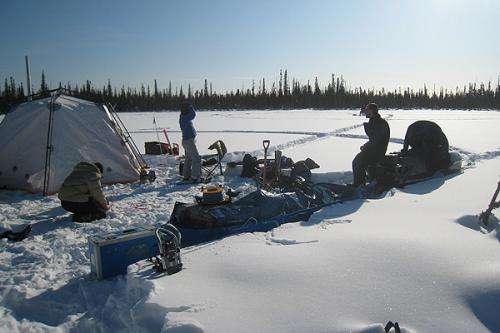Team pioneers new way to survey thawing Arctic

(Phys.org)—In the snow of Alaska, a Stanford-led team of researchers has found a new way to determine if the soil beneath lakes, normally frozen, is thawing as a result of climate change. If so, the lakes could become a new source of methane, a global warming gas.
The arctic permafrost is thawing, and not just at the surface. The frozen terrain conceals regions of liquid groundwater containing the right mix of conditions to pose a new risk to the global climate. Now a Stanford-led team has demonstrated a new way to map these expanding liquid regions. Its findings are being published online this month in Geophysical Research Letters.
"These measurements go toward a better understanding of how permafrost thaw processes may impact future climate," said lead researcher and Stanford post-doctoral scholar in geophysics Andrew Parsekian.
The term "permafrost," coined in 1943 by Stanford alum Siemon Muller, applies to ground that stays frozen all year long – approximately a quarter of the Northern Hemisphere. But low spots in permafrost terrain can fill with meltwater, forming small lakes. These lakes can thaw the permafrost beneath them, forming a pocket of unfrozen soil called a "talik."
The thawed talik contains plenty of organic material to feed hungry soil microbes, which generate methane as a byproduct of decomposition. Methane is a potent greenhouse gas, and scientists worry that methane released from Arctic permafrost could start an unstoppable feedback loop.
"This is a new carbon pool being turned on under climate warming," Parsekian said.
His team, comprising researchers from the U.S. Geological Survey, Rutgers University, University of Alaska Fairbanks, and Leibniz Institute for Applied Geophysics in Germany, used nuclear magnetic resonance, or NMR, to assess the extent of a talik beneath an Arctic lake.
Camped on the frozen surface of Lake Caribou, near Fairbanks, Alaska, they set out loops of wire up to a football field in diameter, which created an electromagnetic pulse in the ground and water below. That pulse caused protons in talik water to wobble in a way Parsekian's team could detect.
NMR is the same technology used in a medical MRI, which uses magnets 10,000 times more powerful than a refrigerator magnet to perturb atoms. As those atoms return to their rest state, detectors pick up their unique resonance. Those magnets weigh several tons and are cumbersome to take into the field, so Parsekian used the magnetic field of Earth as his magnet.
NMR is the only subsurface imaging method, he said, that is directly sensitive to unfrozen water content. The researchers checked the water and ice in nearby wells to confirm that the NMR measurements were providing accurate information about the situation underground.
Parsekian's team is the first to use NMR to detect taliks.
"By understanding that we have a really good method to make these measurements," Parsekian said, "we can scale it up into a larger regional study that will be able to change the way we think about Arctic permafrost."
Field conditions in Alaska were sometimes brutal. The team encountered temperatures as low as 40 degrees below zero, and used portable furnaces to keep their instruments from freezing.
Parsekian loves the adventure of working in Alaska. It's why he keeps going back. "It's a wild place," he said. "It's always exciting."
Parsekian works with Professor Rosemary Knight's Environmental Geophysics research group. "We've made tremendous progress over the past three years in advancing the use of surface NMR for characterizing groundwater systems," said Knight. "This came along as a unique opportunity to apply what we've learned to an important problem – the thawing of permafrost."
More information: onlinelibrary.wiley.com/doi/10 … 2/grl.50137/abstract
Journal information: Geophysical Research Letters
Provided by Stanford University


















